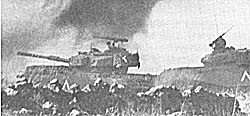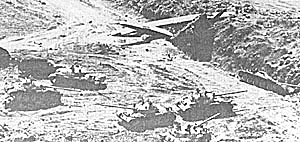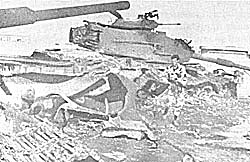Here, then, are the revisions to Tractics that I'm sure you've been waiting for since reading my introductory verbiage, which will update your modern armor miniature rules.
T62 and T55
Rate of Fire: 1/2*
Range Finder: Good to 3200' (38") Must track for at least 1/4 of a turn's movement (Consecutive) before firing.
Accuracy Penalty: -8 from base at targets beyond 4500' (54")
Damage: On frontal glacis and flank hits by APDS and HEAT that fail to penetrate, roll 2 dice. A roll of 4 or less causes sufficient external "disruption" to ignite fuel or ammo.
Same procedure for small arms fire against the external fuel tank.
After a penetration, add +1 to the roll for damage to simulate vulnerability of internal elements to fire.
Due to mechanical unreliability of the tanks, treat as WWII 20-50-ton vehicle under optional rule.
APDS hits that fail to penetrate have a small chance of hitting a weak spot in the armor and still piercing, so roll 2 dice and a or less results in a "freak hit" penetration.
Direct Fire Procedures: Since the tank gun does not "depress" more than 3º, more tank must be exposed during hulldown positioning, and a modifier of only -4 is used (versus usual -8).
These tanks are treated as "0 addition modifier types" for hit/miss determination.
Due to tactical reliance on rangefinders, Soviet tanks may not utilize "cover fire" technique.
*Or, if this is too unwieldy, allow all Western tanks an extra shot if an "8" or better is rolled with two dice at the start of their fire.
Lest you think these rule revisions come down too hard on the poor Soviet tanks and their crews, keep two things in mind: First of all, I usually play the "bad guys" during modern armor games which means I personally apply all of the penalties and have to live with them, so you know they're fairly reasonable. Lastly, T62s and T55s were called "flaming coffins" by the Warsaw Pact observers, whom one would normally expect to be pro-Soviet (at least in the press).
M60/M48
In these tanks, and the Centurion, the tank commanders rode with their upper torsos exposed in order to improve visibility and firing procedure. The commanders are therefore particularly vulnerable to HE, HEAT and APDS hits on the turret, a fact which the opposition should try to take advantage of.
-3 from base at targets beyond 6000' (72 inches), but the Israelis get to retain the +2 range finder bonus even though they use visual ranging for close-in targets to reflect their lethal accuracy with the 105mm tank gun.
These tanks are heavy tanks, and +2 should be added to the base when firing at them.
Centurion/Ben Gurion/Patturion
Since the ranging machine gun is useless beyond 10,000', there is no bonus for shots at that range (no other method of range finding is used).
The spaced suspension armor may be sufficient to detonate HEAT and HE projectiles before they create any internal damage. In the same light, 40% of HEAT hits on the turret side and 80% of the rear turret hits will land on storage boxes and other gizmos without any significant internal damage (M60 with rear turret screen also gets some protection). This is an ordinary tank target (+1 to base) as it projects 15% less target area to enemy gunners than an M60 (which is like shooting at a whale with its enormous turret and large, high chassis - the Cadillac of tanks).
While this tank fires slightly faster than an M60, only give it a ROF of 1 or your Israeli opponents will buy them by the dozens.
The frontal hull armor should be 152mm at 60º, since this is the heaviest armored tank during the war and 100mm at 45º as listed for the Centurion 10 is far too low (while I can't find any turret front armor data, 250mm vertical seems reasonable and should be used until better data is obtained).
All Israeli tankers get a bonus of +5 to the base when checking morale after their tank is immobilized or penetrated to simulate their greater propensity to stay in their tanks and fight until the bitter end.

The Few Israeli Centurions on duty at the front when the Syrians attacked (right) scored a 13:1 kill ratio. Mute testimony are the syrian AFV's in the photo at the below. A T-55 lies in the anti-tank ditch. The group of T-62's in the foreground were captured almost intact. Soviet tactics employed by the Arabs relied on overwhelming numbers, not skill, to overcome the Israeli defenders. Once the Syrians broke through , they lacked the initiative to complete their victory. Israel then quickly counterattacked and pushed the Arabs back towards Damascus.
T62 Tactics In TPACTICS
 Regarding the strategies of victory for the Soviet tanks with the recommended rules modifications, one will have to have a lot of tanks to start with (to absorb losses),and quite a bit of resourcefulness and determination to defeat your opponent who has far better equipment. The actual Soviet tactics (also used by the Arabs) during long range duels involve mass fire against one target, which is obvious due to the poor accuracy of the guns. If you must engage in cross-country gun duels, the HEAT is the name of the game 'cause 115mm HEAT from the smoothbore will kayo even the turret of an M60, but expect to lose quite often against hulldown M60s and Centurions who will outshoot you every time.
Regarding the strategies of victory for the Soviet tanks with the recommended rules modifications, one will have to have a lot of tanks to start with (to absorb losses),and quite a bit of resourcefulness and determination to defeat your opponent who has far better equipment. The actual Soviet tactics (also used by the Arabs) during long range duels involve mass fire against one target, which is obvious due to the poor accuracy of the guns. If you must engage in cross-country gun duels, the HEAT is the name of the game 'cause 115mm HEAT from the smoothbore will kayo even the turret of an M60, but expect to lose quite often against hulldown M60s and Centurions who will outshoot you every time.
It is far better to close rapidly and then use the accuracy of the Soviet guns within 1500 meters to close the technological gap and even things out a little. The Avalon Hill game, Arab-Israeli Wars is an excellent simulation of the conflict on a platoon level, and can be used to try out tactics during free moments, when breaking out the minis would be a chore. In fact, the terrain layouts are not only an excellent source for creating interesting layouts for miniature battles, but playing the game a few times will impress even the most out-and-out blitzkrieger of the vital importance of using terrain to both cover one's advance and to get the most out of the tanks one has to play with (slow advances are almost a rule-of-thumb for the Arab players).
The T62 player should also make the use of HEAT a standard, since the opportunities to close within 2000'-3000' of the Centurions is sort of rare (at least against decent opponents), and the damage caused by 115mm APDS is not that much greater than the destructiveness of HEAT. The lucky guy who gets the Western tanks this time (remember the junky Shermans of WWII, well the situation has now completely reversed itself) must start flinging APDS once the enemy closes within 6000' or so since the 105mm HEAT has very low damage potential (even with the previously recommended add-ons) and APDS is the only way to blow through the excellent turret armor of the T62 (which is one bright aspect in a pretty sad picture, since 35% of all hits will land on the turret).
Both players may, from time to time, approach the enemy at a quarter angle, versus full face, but the little extra increase in effective armor thickness (it adds 20% in thickness) is counterbalanced by the exposure of the flank armor to a 45% chance of getting hit (only 35% if you point your turret at the firing tank), which is a losing proposition unless the flank armor is as thick as the front (Tigers are about the only AFVs that meet that standard).
Showing your flank also exposes the engine compartment, which in T62s will ignite upon being hit (it's a magnesium alloy).
The only benefit of giving your opponent the full profile treatment, and it's a last ditch kind of thing, is the 45º quarter view. The frontal armor will enjoy an increase of 40% in effective thickness and HEAT shells will bounce off the glacis (keep the turret pointed towards your adversary, however), but 45% of the hits will plop against the flank and unless they hit a bogie wheel, desert birds (perhaps some of my relatives) will use the remaining fragments of the tank for protection from the sun. 45 degree facings are mostly for 'Vegas types and those who dig Omar Khayyam and meditating upon fate, death and the futility of it all (which sums up the results of the tactic exceptionally well).
The most difficult thing for the Arab/Soviet player is the ability to keep up with the shots pumped out by the higher ROF of your opponents. Unless some tanks are held back from firing during the previous turn, attempts to move up on the enemy may end up like the Charge of the Light Brigade, as M48s fire away at the swarms of reckless tankers without having to suffer from any distracting shells (remember someone sits stop the tank and directs everything, and they breathe easier when they aren't flinching from Mach 7 projectiles whizzing by). Next turn, when the Arabs have primed their weapons, the Centurions can smartly withdraw to the next sand dune, having had their fun shooting up the enemy and then polling out without a casualty. Even running from dune to dune will help, as long as the T62s see you for less than 25% of the max movement rate, due to their strict beliefs in the range finder.
While I've once again carried on beyond my initial goal of just presenting a few revisions to Tractics, perhaps now you readers out there can appreciate the fascinating and realistic problems that are presented when Tractics is updated to include some of the factors that presently shape the nature of modern armor tactics and strategy. It's certainly more fun than fighting with tanks that look and act exactly the same, or come pretty close to duplicating one another. And after you win, especially with the Forces of Ivan, you'll have accomplished a most difficult and complicated feat (but don't make too much noise, or some night the KGB might knock on your door and make you explain how you accomplished such an unbelievable thing with a demented, limited Capitalist mentality).
For those who would like to pursue further the technical comparisons of the tanks from the 1973 Arab-Israeli War, but desire "easy reading" sources, I'd like to strongly recommend SDC's booklet, Arab-Israeli Armor 1973, which provides a very comprehensive and entertaining description of the tanks that fought during the war. Much of the material used to "revise" Tractics came from the SDC booklet (plus some added "misconceptions" of the desert tank characteristics that will have to be blamed on me alone), and for the money, the insights it contains are a must for the modern armor student (plus anyone who likes to look at pictures of the vehicles that are inadequately depicted on the Arab-Israeli Wars counters).
For those of you who use the Wargame Research Group (WRG) rules for the 1950-1975 period, a similar revision can be accomplished rather simply by making the following adjustments:
1. T55 and T62 tanks shoot every other turn to simulate vastly inferior rate of fire.
2. Soviet range finders are ineffective beyond 1000 meters.
3. Only Israeli tankers can take "quick shots" without using a rangefinder; Soviet tanks must track for full interval before opening fire (despite range finder inadequacy).
4. Soviet tanks only get -1 modifier for being hull down.
5. If you score a hit on a T55 or T62 but fail to destroy it, roll 1 die. A roll of 6 indicates a "freak hit" that ignites the target and totals it.
6. Subtract 1 from APHE and HEAT damage rolls against the flank of Centurions to simulate hits on stowage boxes and side skirts.
7. Centurion frontal armor should be rated AA (304mm effective versus 220mm for M60).
8. As an alternate to number 5, treat T55/T62 armor as "B" class.
NOTES ON MODERN ARMOR
 photo: Israeli M60 - Victims of Arab AT missiles
photo: Israeli M60 - Victims of Arab AT missiles
One of the greatest peculiarities of modern tank design is the way the armor thicknesses are chosen for the MBTs, especially in view of the data that is available on gun effectiveness.
Using the data from Tractics as a source, one can see that APDS ammo's ability to penetrate 300mm of plating falls off rather quickly, with most of the penetration being in the 200-300mm category after a 3000' range is in effect. Yet, despite the relatively low penetrating capability of the shot beyond 900 meters, the glacis armor of all MBTs (except for the Ben Gurion and a few others) is only 200mm effective full face (100mm at 60(), and 240mm if a quarter shot is made.
What makes the situation even more unusual is that the turret armor of the T62, M40A1 and M48 tanks are all over 240mm (effective full face), with the T62 and M60A1 in the 300mm range, which implies some recognition of the armor required to defeat APDS at medium ranges.
The obvious failure to keep the glacis armor up to a reasonable level, or at least on par with the turret, no doubt contributed to the demise of many tanks during the 1973 war, whose crews were not aware of the sub-par thicknesses.
In the absence of the 2 inches or so of added thickness which would have defeated many of the mid-range hits that fried T62 crews, the tactical policies for success or even elongated survival in a world of 4800-fps shells have to be based on a combination of two factors: multitude and cover. In other words, lots of tanks to assure that some survive to carry the attack home, and plenty of hulldown positions to guard the fragile glacis armor.
It is still somewhat unbelievable that the Soviets, and even American tank designers to a good degree, could have so badly neglected the frontal armor thickness in their work. While the Soviets may have based their hopes on small target size, it's obvious that the bloated M60 cannot even attempt to disguise the poor design with any "coverup" excuses. Basically, it's just another case of poor engineering.
The implications of having 300mm of effective armor go well beyond just being able to defeat APDS.
When the initial attempts to crack open the T62 with APDS would have failed against the hypothetical 300mm thickness (150mm at 60(), the Israelis would have had to resort to HEAT to defeat the Arabs. HEAT, however, imparts considerably less damage after penetration and coupled with the lower accuracy of HEAT against moving targets (compared to APDS) the Arabs in their Soviet tanks would have stood a better chance of victory.
In addition to the oversight with regard to frontal armor (how much can 2 extra inches of plate affect a tank's performance?), the flanks have also been sadly neglected. Just as the Panther's brilliant frontal armor design was negated by a vulnerable side armor (it needed its speed to avoid flanking), so do the M60s, T62s and M48s overlook the power of small weapons to bust them apart with flank shots.
It's really a crime to see a tank with 300mm of turret armor and 200mm frontal thickness be destroyed by a bazooka or small anti-tank projectile that slices through the 70-80mm side plating and cremates some crew members (just take a good look at the square yards of lower hull armor on the M60 that presents itself from the flank, and you'll get an idea of the sorry state of modern tank design). While the Centurion is almost an antique now due to its WWII origins, the side skirting that it carries (a leftover from the WWII efforts to safeguard the flanks) can make a world of difference against gnatlike anti-tank guns, rocket grenades and other pesky little devices that can neutralize the sophisticated, expensive armored monsters under the right circumstances.
While the preceding discussions has nothing to do with modernizing those Tractics rules, it does point out certain facts regarding the vulnerability of the seemingly superior tank designs that can (and should) affect tank tactics (need for hulldown positioning, danger of exposing the flank, need to screen off infantry from the AFVs due to the potency of their arms against tank side armor, and the value of the Centurion for anti-personnel duty).
Given the almost unlimited number of factors that come into play while using the modern armor rules of Tractics, being a successful tank commander requires not only a flair for tactics but a computer nearby to calculate the statistical probabilities of success bases on 9,000 input parameters (R2D2s come in very handy here, but they always seem to cry when their mechanical brethren - the tanks - are destroyed, which limits their usefulness).
Revisions and Notes on Modern Armor
Modernizing Those Modern Armor Rules
Glossary of Terms
Back to Campaign #92 Table of Contents
Back to Campaign List of Issues
Back to MagWeb Master Magazine List
© Copyright 1979 by Donald S. Lowry
This article appears in MagWeb (Magazine Web) on the Internet World Wide Web. Other military history articles and gaming articles are available at http://www.magweb.com